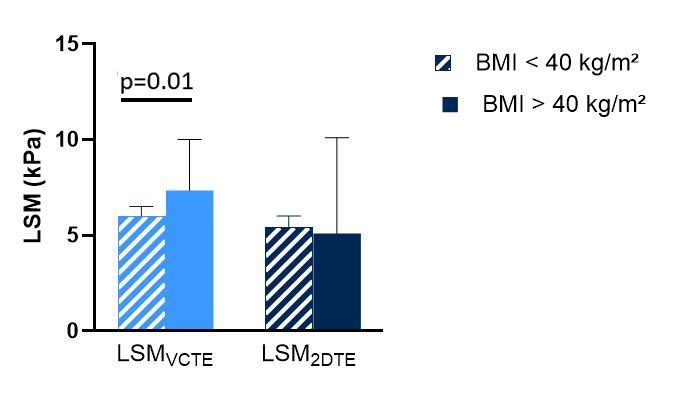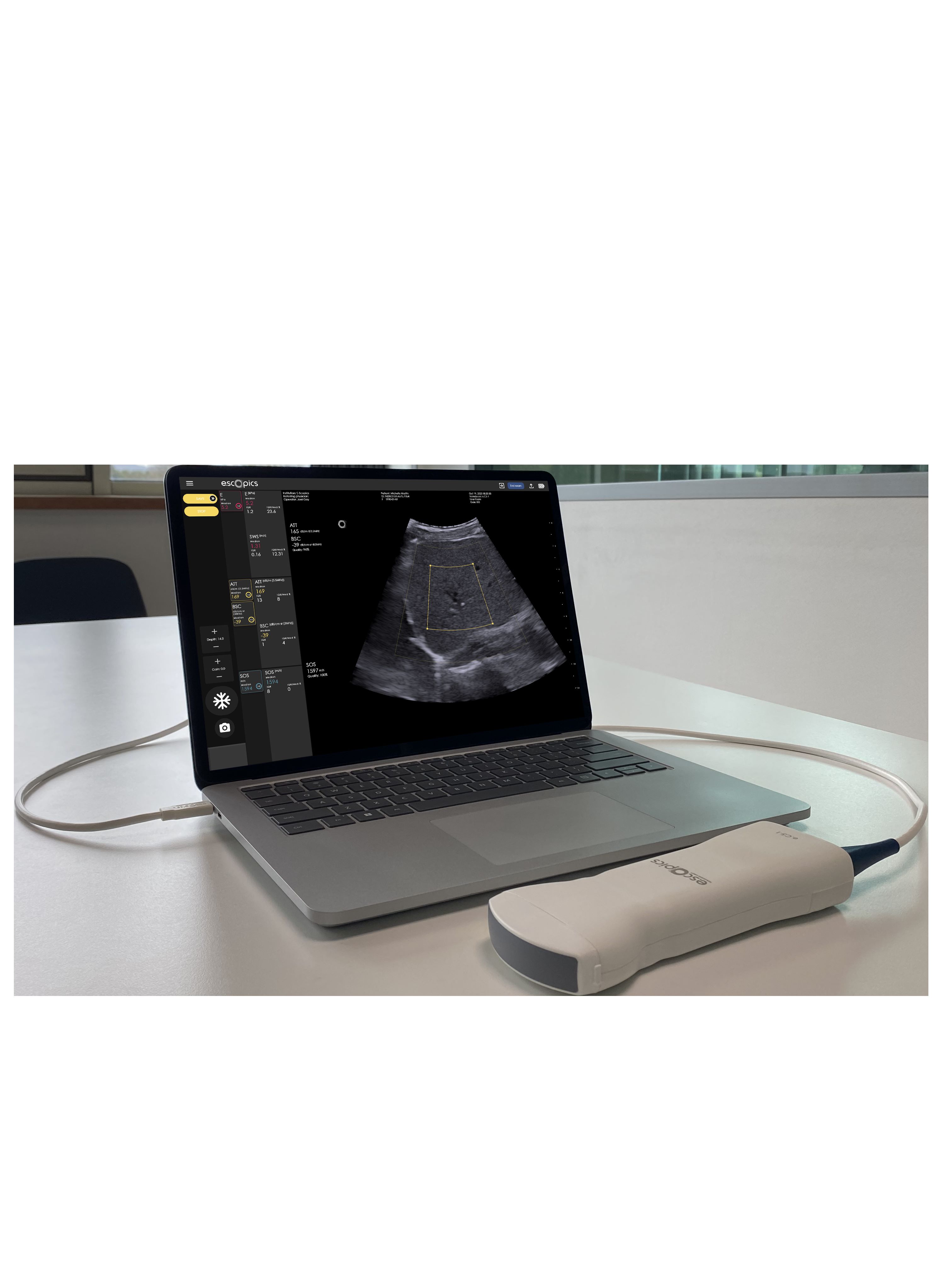Sunday Poster Session
Category: Liver
P1521 - LSM in Patients With MASLD Using Hepatoscope Is Comparable to Fibroscan and Not Affected by BMI
Sunday, October 26, 2025
3:30 PM - 7:00 PM PDT
Location: Exhibit Hall

Braden Thomas, MD
Mercy Medical Center
Baltimore, MD
Presenting Author(s)
Braden Thomas, MD1, Kristin Lescalleet, DO1, Cindy Serdjebi, PhD, PharmD2, Joel Gay, MSc2, Mekonnen Lema, BS1, Paul Thuluvath, MD1, Anurag Maheshwari, MD1
1Mercy Medical Center, Baltimore, MD; 2E-scopics, Aix-en-Provence, Provence-Alpes-Cote d'Azur, France
Introduction: IIn obese patients, abdominal fat may affect the reliability of liver stiffness measurement (LSM) with FibroScan®VCTE as studies show accuracy rates of 60% in populations with BMI >40. Ultrasound (US) is often required to find the best location for LSM, extending time and cost. Screening of patients with metabolic-dysfunction associated liver disease (MASLD) could benefit from a portable US imaging system with associated transient elastography (TE) to risk-stratify liver fibrosis. The aim of this study was to evaluate Hepatoscope® (E-scopics Inc.), an 2D-US portable device with associated TE in patients with MASLD at differing BMI levels, and to assess its non-inferiority as compared to FibroScan (Echosens Inc).
Methods: From August to December 2024, 174 MASLD patients scheduled for FibroScan exam at Mercy Medical Center were enrolled in this prospective study. The patients underwent a second exam with Hepatoscope 2DTE (v2.1.5). LSMVCTE was valid if there were 10 or more exams with interquartile range/median ratio below 30%,. LSMVCTE and LSM2DTE were compared by a Mann-Whitney test, Spearman’s correlation with a Deming regression model. Impact of body mass index (BMI) on both LSMVCTE and LSM2DTE was assessed.
Results: 174 patients were evaluated using both tests . Baseline demographics included median age 59.0 [48.3 - 67.0], BMI 30.82 [26.99 - 35.45], 97 (53.8%) female, 99 (55.0%) had BMI > 30 with 20 (11.6%) with BMI > 40. 102 (56.7%) had type 2 diabetes. Distributions of LSM2DTE and LSMVCTE were not significantly different (5.4 kPa [4.4 - 7.7] and 6.1 kPa [4.6 - 9.0], respectively). They both correlated strongly (r = 0.64, 95%CI: 0.5532 - 0.7281) and there was no significant bias. LSMVCTE had a weak but significant trend to increase with BMI (r = 0.2633 95%CI: 0.1149 - 0.4003, p = 0.0004) and patients with severe obesity (BMI > 40 kg/m²) had higher LSMVCTE (p = 0.011). This was not observed with Hepatoscope where LSM2DTE measurements were found to be independent of BMI.
Discussion: Hepatoscope is a solution for the accurate assessment of LSM in MASLD patients, combining TE and 2D-US imaging, that is FDA approved with CPT codes for billing. Our study demonstrated that Hepatoscope results are non-inferior to FibroScan for LSM assessment. LSM2DTE measurements were independent of BMI, potentially addressing the limitations of other devices. Hepatoscope may offer additional advantages over FibroScan due to its portability and integrated 2D imaging capability.

Figure: Figure 1 shows LSM when adjusted for BMI for FibroScan (light blue) and Hepatoscope (dark blue). Severe obesity (BMI >40) led to a significant increase in LSM measurement on FibroScan as compared to no difference on Hepatoscope.

Figure: Figure 2 shows the Hepatoscope probe attached to a laptop, highlighting the ultra-portability of the device.
Disclosures:
Braden Thomas indicated no relevant financial relationships.
Kristin Lescalleet indicated no relevant financial relationships.
Cindy Serdjebi: E-scopics – Employee.
Joel Gay: E-scopics – Employee.
Mekonnen Lema indicated no relevant financial relationships.
Paul Thuluvath indicated no relevant financial relationships.
Anurag Maheshwari indicated no relevant financial relationships.
Braden Thomas, MD1, Kristin Lescalleet, DO1, Cindy Serdjebi, PhD, PharmD2, Joel Gay, MSc2, Mekonnen Lema, BS1, Paul Thuluvath, MD1, Anurag Maheshwari, MD1. P1521 - LSM in Patients With MASLD Using Hepatoscope Is Comparable to Fibroscan and Not Affected by BMI, ACG 2025 Annual Scientific Meeting Abstracts. Phoenix, AZ: American College of Gastroenterology.
1Mercy Medical Center, Baltimore, MD; 2E-scopics, Aix-en-Provence, Provence-Alpes-Cote d'Azur, France
Introduction: IIn obese patients, abdominal fat may affect the reliability of liver stiffness measurement (LSM) with FibroScan®VCTE as studies show accuracy rates of 60% in populations with BMI >40. Ultrasound (US) is often required to find the best location for LSM, extending time and cost. Screening of patients with metabolic-dysfunction associated liver disease (MASLD) could benefit from a portable US imaging system with associated transient elastography (TE) to risk-stratify liver fibrosis. The aim of this study was to evaluate Hepatoscope® (E-scopics Inc.), an 2D-US portable device with associated TE in patients with MASLD at differing BMI levels, and to assess its non-inferiority as compared to FibroScan (Echosens Inc).
Methods: From August to December 2024, 174 MASLD patients scheduled for FibroScan exam at Mercy Medical Center were enrolled in this prospective study. The patients underwent a second exam with Hepatoscope 2DTE (v2.1.5). LSMVCTE was valid if there were 10 or more exams with interquartile range/median ratio below 30%,. LSMVCTE and LSM2DTE were compared by a Mann-Whitney test, Spearman’s correlation with a Deming regression model. Impact of body mass index (BMI) on both LSMVCTE and LSM2DTE was assessed.
Results: 174 patients were evaluated using both tests . Baseline demographics included median age 59.0 [48.3 - 67.0], BMI 30.82 [26.99 - 35.45], 97 (53.8%) female, 99 (55.0%) had BMI > 30 with 20 (11.6%) with BMI > 40. 102 (56.7%) had type 2 diabetes. Distributions of LSM2DTE and LSMVCTE were not significantly different (5.4 kPa [4.4 - 7.7] and 6.1 kPa [4.6 - 9.0], respectively). They both correlated strongly (r = 0.64, 95%CI: 0.5532 - 0.7281) and there was no significant bias. LSMVCTE had a weak but significant trend to increase with BMI (r = 0.2633 95%CI: 0.1149 - 0.4003, p = 0.0004) and patients with severe obesity (BMI > 40 kg/m²) had higher LSMVCTE (p = 0.011). This was not observed with Hepatoscope where LSM2DTE measurements were found to be independent of BMI.
Discussion: Hepatoscope is a solution for the accurate assessment of LSM in MASLD patients, combining TE and 2D-US imaging, that is FDA approved with CPT codes for billing. Our study demonstrated that Hepatoscope results are non-inferior to FibroScan for LSM assessment. LSM2DTE measurements were independent of BMI, potentially addressing the limitations of other devices. Hepatoscope may offer additional advantages over FibroScan due to its portability and integrated 2D imaging capability.

Figure: Figure 1 shows LSM when adjusted for BMI for FibroScan (light blue) and Hepatoscope (dark blue). Severe obesity (BMI >40) led to a significant increase in LSM measurement on FibroScan as compared to no difference on Hepatoscope.

Figure: Figure 2 shows the Hepatoscope probe attached to a laptop, highlighting the ultra-portability of the device.
Disclosures:
Braden Thomas indicated no relevant financial relationships.
Kristin Lescalleet indicated no relevant financial relationships.
Cindy Serdjebi: E-scopics – Employee.
Joel Gay: E-scopics – Employee.
Mekonnen Lema indicated no relevant financial relationships.
Paul Thuluvath indicated no relevant financial relationships.
Anurag Maheshwari indicated no relevant financial relationships.
Braden Thomas, MD1, Kristin Lescalleet, DO1, Cindy Serdjebi, PhD, PharmD2, Joel Gay, MSc2, Mekonnen Lema, BS1, Paul Thuluvath, MD1, Anurag Maheshwari, MD1. P1521 - LSM in Patients With MASLD Using Hepatoscope Is Comparable to Fibroscan and Not Affected by BMI, ACG 2025 Annual Scientific Meeting Abstracts. Phoenix, AZ: American College of Gastroenterology.
